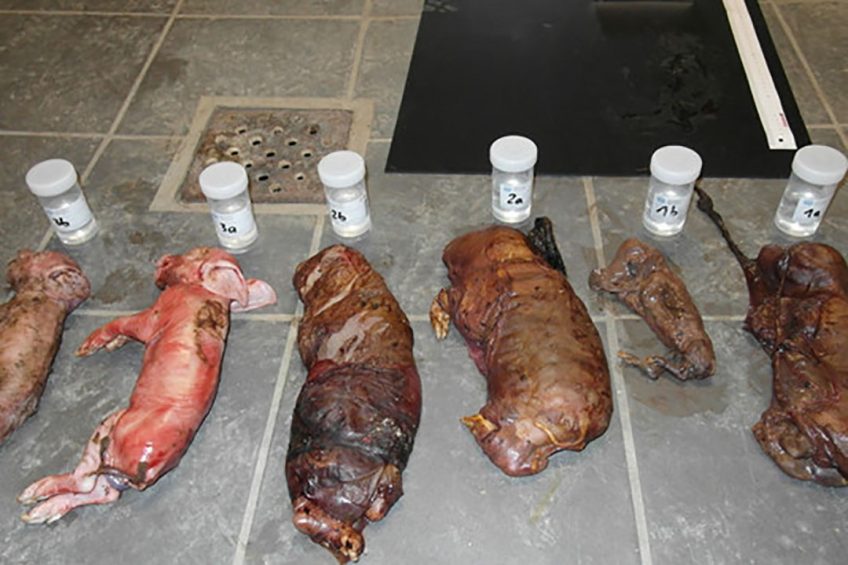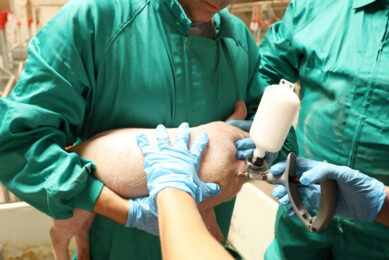Do you want to optimise sow herd productivity?

There are many factors related to loss of productivity in sow herds: Management, housing, nutrition and disease can reduce the throughput of a breeding herd and have a large impact on profitability. Problems are often complex and require detailed examination of production records, clinical evaluation of the herd and diagnostic testing.
There are many different infectious causes of infertility in swine, including viruses, bacteria and moulds (mycotoxins). Porcine Parvovirus (PPV), Porcine Circovirus type 2 (PCV2) and Porcine Reproductive and Respiratory Disease virus (PRRSV), are considered the most important infectious agents responsible for infertility and reproduction failure in swine on a global basis.
This article describes a recent case, which illustrates the impact of one of these infections.
CASE REPORT:
Increased mummifications, abortions and stillborn piglets in a gilt herd shortly after total repopulation
This case involves a sow farm in north Germany that was repopulated with 440 gilts. At the genetic multiplication farm, the gilts were vaccinated only against Haemophilus parasuis. 4 groups of 110 gilts each were introduced over a 4 month time period. As reported from the referring veterinarian, all animals were vaccinated against Porcine Parvovirus (PPV), Porcine Circovirus type 2 (PCV2), Influenza A virus, Erysipelothrix rhusiopathiae and Mycoplasma hyopneumoniae on arrival at the German facility. 3½ months after artificial insemination, gilts showed prolonged gestational periods. Increased abortion rates with big variations in the size of the piglets including mummies were observed as well as stillborn and weak born piglets in different litters. In total only 65% of the sows farrowed at all.
Massive clinical symptoms due to a PPV infection?
PPV was suspected to be the underlying cause of disease.
The herd veterinarian took blood samples from affected sows and piglet tissues were also tested in the laboratory. Detailed testing involved histology, immunohistochemistry as well as polymerase chain reaction (PCR). Samples were tested for porcine reproductive and respiratory syndrome virus (PRRSV), PCV2, Parvovirus, Enterovirus, Leptospira sp. and Chlamydia. Feed was also tested for Mycotoxins and for Amino acids (Arginine) deficiencies.
Diagnostic tests revealed an infection with PCV2. Circovirus DNA was detected in blood samples of the affected sows. High virus levels were evident in piglet tissue samples (heart, liver, kidney, lymph node). Characteristic histological lesions in the cardiac muscle were also found in both stillborn and newborn weak piglets confirming Circovirus as the cause of the outbreak.

What can we conclude and what actions did the farm implement?
The presented case reports an unusual severe clinical picture caused by PCV2 infection in pregnant gilts. The cause for this unexpected reproductive disease outbreak was identified to be a delayed PCV2 vaccination, which took place several weeks after introduction of the first 3 gilt groups. Therefore, PCV2 was able to spread among the immunologically naive gilts during 2 months leading to the severe clinical disease during pregnancy. PCV2 virus is known to cross the placenta and result in severe lesions to the developing foetus.
The fourth and last group of gilts introduced to the farm, which was vaccinated immediately after arrival to the herd, was unaffected. To reduce further virus spread, re-vaccination of the entire sow herd with a vaccine licensed for use in breeding pigs (Ingelvac CircoFLEX®) was also implemented.
After implementing a strict vaccination scheme, clinical signs disappeared and reproduction performance improved to expected rates (see table 1).
To optimise reproductive performance it is important to carefully benchmark productivity figures, identify when operating below expectations, carry out a complete investigation of all possible agents and finally perform a detailed review of vaccination programmes and implementation.
Authors: M. Kunze, E. Streckel, Boehringer Ingelheim Vetmedica GmbH











